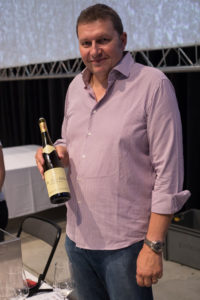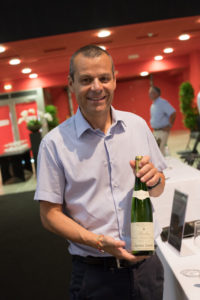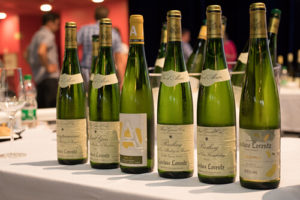When you think of the wines of Alsace, what comes to mind? Riesling, Pinot Gris and Gewurztraminer? The names of Grand Cru sites?
story and photos by Kevin Day
Residual sugar?
Traditionally, the wines of Alsace have not been sweet. Those that were carried the moniker of vendage tardive (VT) or sélection de grains nobles (SGN). Yet in recent decades, residual sugar has crept into many of the region’s dry white wines. The stylistic shift has been a source of consternation for sommeliers, wine critics and (as I found out) Alsace’s winemakers, who are taking stock on the future of the region.
To get a better sense of where Alsace’s wines are headed, I recently traveled to Colmar to attended the biennial Millésimes Alsace. I expected to hear winemakers place an emphasis on the future of natural wines, but in a region that has been at the forefront of the organic or biodynamic movements for a decades now, that’s old news. Instead, many winemakers — young and old — spoke of restoring dryness to the wines of Alsace.
In the age of warmer vintages, that’s proving to be easier said than done.
A Shift in Tradition
Alsace’s continental climate has always been kind to the development of sugar. However, a string of steadily warmer vintages — beginning in the 1990s — brought about radical changes in the vineyard. With an increase in ripeness levels and sugar content in the grapes, winemakers were confronted with a choice: either make high-alcohol wines or leave some residual sugar to keep alcohol in check. Oddly enough, many critics in the late 1990s and early 2000s rewarded wines with sweetness, and from there — well, you can guess where things headed.
“We had a generation before with too much sugar,” Maxime Woerly of Domaine Schaeffer-Woerly* told me. “It was generation Coca-Cola. There were Gewurztraminer and Pinot Gris with 90 to 100 grams of sugar. It was too much.”
Now, winemakers claim that new vineyard practices — such as harvesting based on natural cues of ripeness rather than sugar content alone — have brought things back in balance.
At the trade tasting — where 100 producers poured a selection of Riesling, Pinot Gris and Gewurztraminer — several winemakers discussed the shift.
“Alsace can produce anything,” Olivier Humbrecht of Domaine Zind-Humbrecht told me. “And that can be a problem.”
Because of its climate, winemaking is almost too easy. The problem lies in managing ripeness. Humbrecht seemed to suggest that, in the recent past, winemakers had perhaps spent too much time focused on balance once the grapes were in the winery. They should have looked for it in the vineyard.
A Return to Form

Now, it appears many have figured it out. Domaine Zind-Humbrecht’s wines have long set the benchmark for excellence in Alsace, and they continue to do so, even if many of their wines have varying degrees of residual sugar. The 2016 Grand Cru Rangen Clos Saint Urbain — with a residual sugar of 2 grams per liter — displayed some of the most potent notes I have ever detected in a Riesling, with dried orange peel and crushed herbs complementing the variety’s telltale aromas of apple, lime and petrol.
Humbrecht — whose obsessive attention to detail is legendary — has found success in chilling the must before fermentation to identify which yeast cells are best suited for the wine. “It’s like the vikings dipping a baby in the ice water,” he told me. “You want to see which ones are the strongest. Otherwise, they eat everything.”
Wines from Josmeyer at Millésimes Alsace.
The sheer abundance of high-quality producers at the event amazed me. Highlights included Josmeyer’s detailed 2014 Grand Cru Brand Pinot Gris, the exotic aromas of Barmes-Buecher’s 2015 Grand Cru Steingrübler Riesling, and Léon Beyer’s extraordinary 2011 Comtes d’Eguisheim Grand Cru Pfersigberg Riesling which left me fumbling for words in my notebook (“Wild,” I wrote. “So wild.”)
Sweetness Still Has Its Place

But were the best wines from the event the best because they had low residual sugar?
Not exactly. Perhaps “balance” was a better way of looking at it. Across the spectrum, the white wines — particularly the Riesling –- played sleight-of-hand tricks with my palate, riding waves of pure fruit, elegant acidity and yes, in some cases a touch of residual sugar. There was a harmony in these wines that felt fresh and vital; the feathery traces of sugar seemed like necessary personality traits.
This was best on display when I met Georges Lorentz of the winemaking house Gustave Lorentz. He proudly poured a sip of the domaine’s 2011 Grand Cru Altenberg de Bergheim Gewurztraminer which features 28 grams/liter of residual sugar. Unlike most vineyards in Alsace, the Grand Cru Altenberg de Bergheim regularly encounters the development of botrytis, which was faintly noticeable on the palate.
Gewurztraminer has always rubbed me the wrong way, and I told him as such. This one, however, was a delight. Was it because of the residual sugar?
Georges shrugged. “The nose of Gewurztraminer is sweet,” he told me. “So when it is dry, something (to our senses) is confusing.” Perhaps. Or maybe I was just finding the wine’s blend of rosehips, herbal tea and peach-like aromas — as well as elegant and lean acidity — to be pure comfort.
Wines such as this — or Cattin’s 1997 Grand Cru Hatschbourg Pinot Gris, which I sampled later on the trip — would be a hard sell with many of my colleagues and friends. But pour it blind alongside a plate of fish tacos, and it could convince anyone that a little residual sugar has its time and place, too.

*Note: This winery is not currently imported into the United States.
